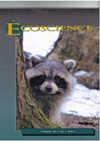印度北部潮湿热带落叶林中筑丘白蚁的丰度、种群密度和空间生态
IF 1.3
4区 环境科学与生态学
Q3 ECOLOGY
引用次数: 5
摘要
丘白蚁是生态系统工程师,其数量和空间生态学在许多森林生态系统中没有得到充分的解决。我们研究了印度北部杜恩山谷两个潮湿的热带落叶林(纯萨尔和萨尔柚木混合)中的Odontotermes obesus丘。通过直接计数、最近邻分析和破坏性采样分别确定了丘的丰度、空间格局和白蚁种群密度。利用回归分析在精细空间尺度上测试了丘属性与林分特征之间的关系,如木本植被多样性、密度和树桩(代表食物质量、数量、开放空间可用性和干扰)。纯Sal林分(~8.0丘/公顷)的活动丘比混合林分(~5.0丘/ha)更丰富。平均种群密度(两个地点的总和)为每个土丘2.01×105个个体。种群密度与土丘体积呈强相关。年轻群体的优势表现为小土堆(<1.25m3)的高发生率(≥65%)。丘主要是随机分布的。然而,纯萨尔林分表现出局部聚集的趋势。我们的研究结果表明,木本物种丰富度是一个重要的、特定地点的调节因素。在扩大O.obesus丘对各种生态系统过程的贡献时,应谨慎考虑当地规模的变化。本文章由计算机程序翻译,如有差异,请以英文原文为准。
Abundance, Population Density and Spatial Ecology of Mound-Building Termites in Moist Tropical Deciduous Forests of Northern India
ABSTRACT Mound-building termites are ecosystem engineers whose abundance and spatial ecology are not adequately addressed in many forest ecosystems. We studied Odontotermes obesus mounds at two moist tropical deciduous forests (pure Sal and Sal-Teak mixed) in the Doon valley, northern India. Mound abundance, spatial pattern and termite population density were determined by direct count, nearest neighbour analyses and destructive sampling, respectively. Relations between mound attributes and stand characteristics such as woody vegetation diversity, density and tree stumps (representing food quality, quantity, open-space availability and disturbance) were tested at fine spatial scale using regression analyses. Active mounds were more abundant in the pure Sal stand (∼8.0 mounds/ha) than in the mixed stand (∼5.0 mounds/ha). Mean population density (both sites combined) was 2.01 × 105 individuals per mound. Population density was strongly correlated with mound volume. Predominance of young colonies was indicated by high occurrence (≥ = 65%) of small mounds (< 1.25 m3). Mounds were predominantly randomly distributed. However, the pure Sal stand showed a partial tendency towards aggregation. Our results revealed that woody species richness is an important, site-specific regulatory factor. Local-scale variations should be cautiously considered while up-scaling the contribution of O. obesus mounds to various ecosystem processes.
求助全文
通过发布文献求助,成功后即可免费获取论文全文。
去求助
来源期刊

Ecoscience
环境科学-生态学
CiteScore
2.80
自引率
0.00%
发文量
13
审稿时长
>36 weeks
期刊介绍:
Écoscience, is a multidisciplinary journal that covers all aspects of ecology. The journal welcomes submissions in English or French and publishes original work focusing on patterns and processes at various temporal and spatial scales across different levels of biological organization. Articles include original research, brief communications and reviews.
 求助内容:
求助内容: 应助结果提醒方式:
应助结果提醒方式:


